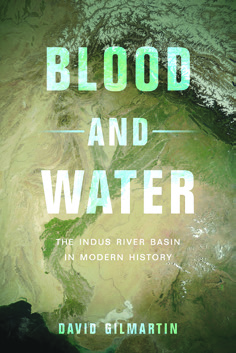Environment & Ecology
Changing Human Relations with Nature | In Conversation with Prof. David Gilmartin
LA 59 |
|
| Professor of History at North Carolina State University, David Gilmartin has to his credit many scholarly papers and books. His research interests focus on the intersections between the history of British imperialism in South Asia and the development of modern politics and forms of rule. His book, 'Blood and Water: The Indus River Basin in Modern History' [2015] focuses on the changes that occurred in the Indus Valley basin as a result of the implementation of the world's largest modern irrigation system by the British in the nineteenth and twentieth centuries. Here he talks about the intersection between environmental and political history, attitude towards nature in the nineteenth century and much more..
|
|
 |
|
Environmental history provides a critical ground for exploring the relationship between communities and environment. Please elaborate on the idea in context of your studies of South Asia. What are the factors across geographies against which one can study the relationship of nature and culture? What are the factors that are specific to the Indian subcontinent?
Environmental history is one of the most vibrant fields in South Asian history, with an increasing number of scholars exploring its parameters. But it has also been marked by differing approaches among its practitioners. For some, the attraction and importance of environmental history lies precisely in its deep grounding in the material world, in its binding of human history to the material realities of nature, within whose contours all human history occurs. For others, environmental history is nothing if not a history of ideas-the story of human ideas about 'nature'-and about how humans have understood 'nature' as something both encompassing of and at the same time distinct from humanity. These ideas are what have had the most profound effects on how human relations to 'nature' have changed over time.
While trying to pay attention to both of these strands, the approach of Blood and Water leans more heavily toward the latter. It does not track in any great material detail the human relationship to the multiplicity of plants and animals that have historically occupied the Indus basin, however important that story is. Rather it tracks the connections between human conceptions of nature- and of spatially imagined 'environments'- and human conceptions of 'community'. I treat 'community' in this context not as a 'thing', but as an idea, operating on multiple scales [from the local to the river basin to, ultimately, the national and the global], defining how human beings have conceptualized their collective interests and commonalities. The concept of 'environments' provides a critical framework in this context for thinking about how such conceptions of community have been spatialized-and tied to politics. By focusing on the relationship between 'environment' and 'community', I thus suggest the inescapable connection of environmental to political history. In the face of state ideologies that have stressed the 'apolitical', and scientific foundations for policies transforming the environment, this focus on connections between 'environment' and 'community' provides the foundations for suggesting that environmental and political history are impossible to separate.
If we look at the history of South Asia, there emerge strong cultural differences in the way nature was perceived before and after the British arrived in India; the social, cultural, sustainable, and mythological aspects giving way to the engineering and productive aspects. It is true that significant changes shaped attitudes towards nature in the nineteenth century, particularly in terms of the state's rhetorical projection of itself as a force for transforming nature in the name of what came to be known as 'development'. At the same time, to see 'social, cultural, sustainable, and mythological' elements in attitudes towards nature as 'giving way' to engineering and productive visions misleads. Such visions were in tension before the British arrived, and they continued to be in tension subsequently.
The concern for turning nature to productive 'use' was hardly an innovation of the British. What changed during the colonial era was the way that the British state projected a vision of state sovereignty linked to a cosmology defined by science and the magic of reasoned human 'objectivity'. This vision lay at the very heart of the concept of 'development' as both a material policy and an expression of what the British [and many educated Indian elites] saw as the 'developing' human capacity to stand apart from nature and transform it through 'reason'. This was the most powerful legitimizing foundation for British rule. In critical ways also underlain by racial thinking, this British vision of the colonial state as more rational and scientific than the peoples of the Indus basin, whose culture and religion undercut their ability to 'objectively' stand apart from 'nature', was thus built into the structure of British perceptions that underlay the Indus basin's environmental transformation.
But 'social, cultural, sustainable and mythological' elements nevertheless continued to shape community interactions with environments during the British period as much as they had before. Nor had these been divorced in the period before the British from structures of state power. There were many modes of productive adaptation to local environments in the Indus basin that intersected with forms of community organization, often shaped precisely by mechanisms to adapt to environmental uncertainty through multiple modes of productive interaction with nature. But these were intimately related also to shifting forms of state authority, and to the relationships of strategies of production- and projections of community-to changing structures of state power and legitimation, both before and after the arrival of the British. A discussion of some of this structure is at the heart of the book's case study of irrigation on the Baloch frontier in the mid-nineteenth century as the British moved into this region.
Viewed in this way, it is questionable as to whether the term 'sustainable' is very useful in tracking forms of environmental adaptation historically. It is certainly true that 'developmental' policies have in recent decades pushed water usage in the Indus basin beyond what might be called 'environmental constraints'. But to the very considerable extent that the history of forms of environmental adaptation have been powerfully connected to shifting structures of politics and state authority, the meaning of 'sustainable' cannot be divorced from the history of political systems. Viewed in this context,'sustainability', as a term suggesting a world whose politics is not continuously in flux, has little historical traction.
|
|


|
|

|
|
|
|
|